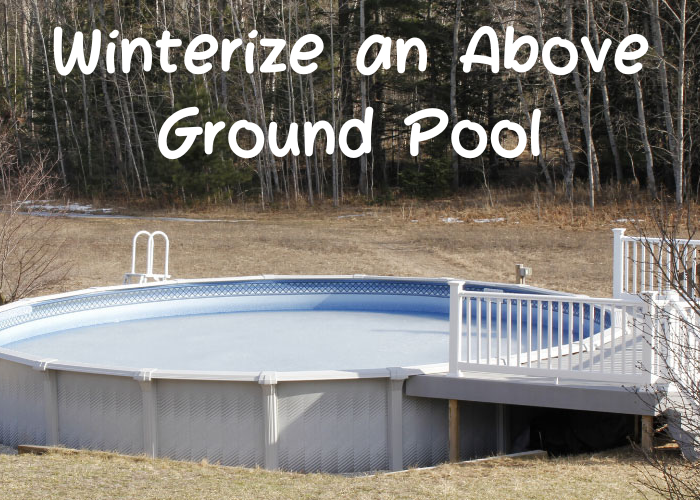As winter approaches, it’s essential to take the necessary steps to protect your above ground pool from damage caused by freezing temperatures. Winterizing your pool may seem like a daunting task, but it’s crucial to ensure that your pool is in top condition when the warmer months return. In this guide, we’ll take you through the essential steps to winterize your above ground pool properly.
Why Winterizing Your Above Ground Pool is Important
During the winter season, an above ground pool got damaged. It is important to Winterize your above ground pool to prevent any damage. There is much damage which is caused because the water freezes, such as the pool’s walls, pipes, and other components. By winterizing your pool, you’re taking the necessary precautions to prevent this from happening.
In addition to protecting your pool from damage, winterizing your above ground pool can also save you money in the long run. If you properly winterize your pool, you’ll prevent any costly repairs that may be needed if your pool is damaged during the winter months.
Important Steps that Can Help You to Winterize Your Above Ground Pool
Cleaning and Preparing the Pool Before Winter
The first step in winterizing your above ground pool is to clean and prepare it before the cold weather sets in. Start by removing any debris from the pool, including leaves, sticks, and other items that may have fallen in. You can use a skimmer net or vacuum to remove these items.
Next, you’ll need to clean the pool’s walls and floor. Use a pool brush to scrub away any dirt or algae that may have built up over the summer months. Once you’ve cleaned the pool, it’s time to lower the water level.
You can lower the water level by using a submersible pump or a pool vacuum. Lower the water level to just below the skimmer level. This step is essential as it prevents water from freezing in the skimmer, which can cause significant damage to your pool.
Balancing the Water Chemistry for Winter
After cleaning and preparing the pool, it’s time to balance the water chemistry. Start by testing the water’s pH level to ensure it’s between 7.2 and 7.8. You can use a pool test kit to test the water.
Next, you’ll need to shock the pool with chlorine to kill any bacteria or algae that may be present. Follow the instructions on the chlorine package for the correct dosage. After shocking the pool, add a winterizing chemical kit to the water to keep the water clean and clear during the winter months.
Removing and Storing Pool Equipment
The next step is to remove and store any pool equipment, including ladders, diving boards, and skimmers. Clean and dry the equipment before storing it in a dry, indoor location. If you’re unable to store the equipment indoors, cover it with a tarp to protect it from the elements.
Draining and Covering the Pool
The final step in winterizing your above ground pool is to drain and cover the pool. Start by draining the pool’s plumbing system, including the pump, filter, and heater. You can use a shop vac to blow out any remaining water in the pipes.
Once the plumbing system is drained, it’s time to cover the pool. Use a winter pool cover that fits your pool’s size and shape. Make sure the cover is tightly secured to prevent any debris from getting into the pool.
Winter Maintenance Tips for Your Above Ground Pool
While your above ground pool is covered and not in use during the winter months, it’s essential to perform some maintenance tasks to ensure it’s ready for use when the warmer weather returns. Here are some winter maintenance tips for your above ground pool:
- Remove any snow that accumulates on the pool cover to prevent it from weighing down the cover and causing damage
- Check the pool’s cover periodically to ensure it’s securely in place
- Make sure the pool’s water level remains below the skimmer level to prevent damage from freezing
- Check the pool’s equipment periodically to ensure it’s still in good condition
Common Mistakes to Avoid When Winterizing Your Above Ground Pool
Though It looks like a straightforward process, there are some common mistakes you should avoid to ensure your pool is adequately protected. Here are some mistakes that should be avoided:
- Not lowering the water level enough
- Forgetting to balance the water chemistry
- Not removing and storing pool equipment
- Using the wrong size or type of pool cover
Professional Pool Winterization Services
If you’re unsure about winterizing your above ground pool or don’t have the time to do it yourself, consider hiring a professional pool winterization service. They have the experience and knowledge to properly winterize your pool and can save you time and money in the long run.
Conclusion
these are some essential steps to protect it from damage during the cold winter months. By following the steps outlined in this guide, you’ll ensure that your pool is in top condition when the warmer weather returns. Remember to perform regular maintenance tasks during the winter months to ensure your pool is ready for use when the weather warms up again.
